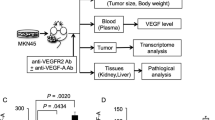Abstract
There is now considerable direct evidence that tumor growth is angiogenesis–dependent1–4. The most compelling evidence is based on the discovery of angiostatin, an angiogenesis inhibitor that selectively instructs endothelium to become refractory to angiogenic stimuli5. Angiostatin, which specifically inhibits endothelial proliferation, induced dormancy of metastases defined by a balance of apoptosis and proliferation6. We now show that systemic administration of human angiostatin potently inhibits the growth of three human and three murine primary carcinomas in mice. An almost complete inhibition of tumor growth was observed without detectable toxicity or resistance. The human carcinomas regressed to microscopic dormant foci in which tumor cell proliferation was balanced by apoptosis in the presence of blocked angiogenesis. This regression of primary tumors without toxicity has not been previously described. This is also the first demonstration of dormancy therapy, a novel anticancer strategy in which malignant tumors are regressed by prolonged blockade of angiogenesis.
This is a preview of subscription content, access via your institution
Access options
Subscribe to this journal
Receive 12 print issues and online access
$209.00 per year
only $17.42 per issue
Buy this article
- Purchase on Springer Link
- Instant access to full article PDF
Prices may be subject to local taxes which are calculated during checkout
Similar content being viewed by others
References
Folkman, J. What is the evidence that tumors are angiogenesis dependent?. J. Nati. Cancer Inst. 82, 4–6 (1989).
Hori, A. et al. Suppression of solid tumor growth by immunoneutraliaing monoclonal antibody against human basic fibroblast growth factor. Cancer Res. 51, 6180–6184 (1991).
Kim, K.J. et al. Inhibition of vascular endothelial growth factor-induced angiogenesis suppresses tumor growth in vivo. Nature 362, 841–844 (1993).
Millauer, B., Shawver, L.K., Plate, K.H., Risau, W. & Ullrich, A. Glioblastoma growth inhibited in vivo by a dominant-negative Flk-1 mutant. Nature 367, 576–579 (1994).
O'Reilly, M.S. et al. Angiostatin: A novel angiogenesis inhibitor that mediates the suppression of metastases by a Lewis lung carcinoma. Cell 79, 315–328 (1994).
Holmgren, L., O'Reilly, M.S. & Folkman, J. Dormancy of micrometastases: balanced proliferation and apoptosis in the presence of angiogenesis suppression. Nature Med. 1, 149–153 (1995).
Key, G. et al. New Ki-67-equivalent murine monoclonal antibodies (MIB 1-3) generated against bacterially expressed parts of the Ki-67 cDNA containing three base pair repetitive elements encoding for the Ki-67 epitope. Lab. Invest. 68, 629–636 (1993).
Gavrieli, Y., Sherman, Y. & Ben-Sasson, S.A. Identification of programmed cell death in situ via specific labeling of nuclear DNA fragmentation. J. Cell Biol. 119, 493–501 (1992).
Folkman, J. Angiogenesis in cancer, vascular, rheumatoid and other disease. Nature Med. 1, 27–31 (1995).
Hamada, J., Cavanaugh, P.G., Lotan, O. & Nicolson, G.L. Separable growth and migration factors for large-cell lymphoma cells secreted by microvascular endothelial cells derived from target organs for metastasis. Br. J. Cancer 66, 349–354 (1992).
Nicosia, R.F., Tchao, R. & Leighton, J. Interactions between newly formed endothelial channels and carcinoma cells in plasma clot culture. Clin. Expl. Metastasis 4, 91–104 (1986).
Alon, T. et al. Vascular endothelial growth factor acts as a survival factor for newly formed retinal vessels and has implications for retinopathy of prematurity. Nature Med. 1, 1024–1028 (1995).
Folkman, J. Tumor angiogenesis and tissue factor. Nature Med. 2, 167–168 (1996).
Teicher, B.A., Holden, S.A., Ara, G., Sotomayor, E.A. & Dong, H.Z. Potentiation of cytotoxic cancer therapies by TNP-470 alone and with other anti-angiogenic agents. Int. J. Cancer 57, 1–6 (1994).
Folkman, J. The vascularization of tumors. Scientific American 234, 58–73 (1976).
Folkman, J. Clinical applications of angiogenesis research. New Engl. J. Medicine 333, 1757–1763 (1995).
Deutsch, D.G. & Mertz, E.T. Plasminogen: purification from human plasma by affinity chromatography. Science 170, 1095–1096 (1970).
Sottrup-Jensen, L., Claeys, H., Zajdel, M., Petersen, T.E. & Magnusson, S. The primary structure of human plasminogen: isolation of two lysine-binding fragments and one “mini-” plasminogen (MW 38,000) by elastase-catalyzed-specific limited proteolysis. in Progress in Chemical Fibrinolysis and Thrombolysis, vol. 3 (eds. Davidson, J.F., Rowan, R.M., Samama, M.M. & Desnoyers, P.C.) 191–209 (Raven Press, New York, 1978).
Kenyon, B.M. et al. A model of angiogenesis in the mouse cornea. Invest. Opthal. Vis. Sci. (in the press).
Author information
Authors and Affiliations
Rights and permissions
About this article
Cite this article
O'Reilly, M., Holmgren, L., Chen, C. et al. Angiostatin induces and sustains dormancy of human primary tumors in mice. Nat Med 2, 689–692 (1996). https://doi.org/10.1038/nm0696-689
Received:
Accepted:
Issue Date:
DOI: https://doi.org/10.1038/nm0696-689
This article is cited by
-
Loss of two-pore channel 2 function in melanoma-derived tumours reduces tumour growth in vivo but greatly increases tumour-related toxicity in the organism
Cancer Cell International (2023)
-
Recombinant human endostatin as a potential anti-angiogenic agent: therapeutic perspective and current status
Medical Oncology (2023)
-
Stem cell factor produced by tumor cells expands myeloid-derived suppressor cells in mice
Scientific Reports (2020)
-
Myeloid-derived suppressor cells in the patients with liver resection for hepatitis B virus-related hepatocellular carcinoma
Scientific Reports (2019)
-
Vessel co-option in cancer
Nature Reviews Clinical Oncology (2019)



